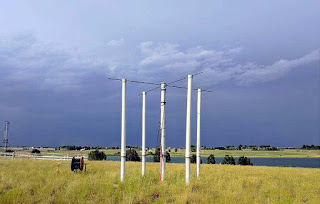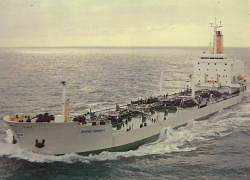 Skunked on my day out.
Skunked on my day out.
| The setup in the car |
| The CHA P loop |
| Reverse Beacon Network |
Mike Weir, VE9KK, is a regular contributor to AmateurRadio.com and writes from New Brunswick, Canada. Contact him at [email protected].
 WWV’s New Antenna On 25MHz – QSA?
WWV’s New Antenna On 25MHz – QSA?
 |
| New Turnstile Antenna / WWV - 25MHz |
Last week's ARRL announcement regarding WWV's new circular polarized Turnstile antenna tests on their 25MHz transmitter quickly garnered my interest.
Their 25MHz signal used to be heard world-wide on F2 until it was dropped in 1977, but somewhat surprisingly, was resurrected in 2014.
I recall hearing its 2nd harmonic on sporadic-E very routinely on 50.000MHz when I first became active on 6m back in the late 60's. Back then it was also not uncommon to hear the 3rd and 4th harmonics of ship CW stations operating on 12 and 16MHz, at the very low end of 6m and just below the band edge on 49MHz.
 |
| 6m Prop Indicator From The 70's! |
Having not listened for WWV's 25MHz signal for several decades, I set up yesterday to see if it could be heard here in mid-summer. Using my Perseus SDR and my LF/MF inverted-L, self-resonant in the middle of the broadcast-band (gosh knows what the pattern looks like up on 25MHz!), I started monitoring just after lunch. I could detect their carrier which was very weak but steady, probably arriving on ionospheric scatter via the e-layer.
A few hours later I re-checked after hearing a few Colorado signals on 6m Es and sure enough, there they were with a fairly robust signal. It too, was no doubt arriving via sporadic-E as it was again today during another widespread Es opening from the PNW to as far south as Puerto Rico.
Here is a recording of the 25MHz signal made this morning with my Perseus SDR along with a comparison recording of their 20MHz signal, made about 30 seconds later.
There is not a lot of difference between the two and both run similar powers ... 2.5kW on 20MHz and 2kW on 25MHz. The 20MHz system uses a half-wave vertical on a 7.5m tower while the 25MHz outlet uses the crossed-dipole circular polarized Turnstile shown at the top of the blog.
Reception reports of their 25MHz signal are being sought and can be e-mailed to WWV at this address.
Steve McDonald, VE7SL, is a regular contributor to AmateurRadio.com and writes from British Columbia, Canada. Contact him at [email protected].
 WWV’s New Antenna On 25MHz – QSA?
WWV’s New Antenna On 25MHz – QSA?
 |
| New Turnstile Antenna / WWV - 25MHz |
Last week's ARRL announcement regarding WWV's new circular polarized Turnstile antenna tests on their 25MHz transmitter quickly garnered my interest.
Their 25MHz signal used to be heard world-wide on F2 until it was dropped in 1977, but somewhat surprisingly, was resurrected in 2014.
I recall hearing its 2nd harmonic on sporadic-E very routinely on 50.000MHz when I first became active on 6m back in the late 60's. Back then it was also not uncommon to hear the 3rd and 4th harmonics of ship CW stations operating on 12 and 16MHz, at the very low end of 6m and just below the band edge on 49MHz.
 |
| 6m Prop Indicator From The 70's! |
Having not listened for WWV's 25MHz signal for several decades, I set up yesterday to see if it could be heard here in mid-summer. Using my Perseus SDR and my LF/MF inverted-L, self-resonant in the middle of the broadcast-band (gosh knows what the pattern looks like up on 25MHz!), I started monitoring just after lunch. I could detect their carrier which was very weak but steady, probably arriving on ionospheric scatter via the e-layer.
A few hours later I re-checked after hearing a few Colorado signals on 6m Es and sure enough, there they were with a fairly robust signal. It too, was no doubt arriving via sporadic-E as it was again today during another widespread Es opening from the PNW to as far south as Puerto Rico.
Here is a recording of the 25MHz signal made this morning with my Perseus SDR along with a comparison recording of their 20MHz signal, made about 30 seconds later.
There is not a lot of difference between the two and both run similar powers ... 2.5kW on 20MHz and 2kW on 25MHz. The 20MHz system uses a half-wave vertical on a 7.5m tower while the 25MHz outlet uses the crossed-dipole circular polarized Turnstile shown at the top of the blog.
Reception reports of their 25MHz signal are being sought and can be e-mailed to WWV at this address.
Steve McDonald, VE7SL, is a regular contributor to AmateurRadio.com and writes from British Columbia, Canada. Contact him at [email protected].
 Amateur Radio Weekly – Issue 165
Amateur Radio Weekly – Issue 165
Sexism in Amateur Radio
Be aware of your unconscious biases.
KD2GTM
New FT8 digital mode from K1JT
This is an incredibly fast mode but not as sensitive as JT65/JT9 as it decodes only down to -20dB.
PE4BAS
Amateur Radio Parity Act introduced to Senate
Parity Act would direct the Federal Communications Commission (FCC) to provide regulatory parity for amateur radio operators.
Senator Roger Wicker
Virginia Tech, Radford University teams readying for eclipse
Three teams of students and faculty from Virginia Tech will be spread out to measure the eclipse’s effects on low frequency radar waves.
The Roanoke Times
New Podcast: The Field Radio Podcast
The Field Radio Podcast is dedicated to exploring the amateur radio hobby through the lens of getting you and your gear outdoors.
HamRadio360
Steps to lower Noise Floor and revitalize AM Radio
Background noise interference is degrading the quality of broadcast reception, two-way communications, mobile cellphone services and every other form of wireless communications used today at an alarming rate.
Radio World
Raspberry Pi rival delivers a 4K Android computer for just $25
The Rock64 Media Board Computer may be a similar size to the best-selling $35 Raspberry Pi but its specs help it to stand apart.
TechRepublic
Decode HD Radio on RTL-SDR
A cybersecurity researcher has cracked the codec used by the NRSC-5-C standard for US based terrestrial digital radio.
K2DLS
Porch portable
During a break visiting relatives in Western NC I went outside, threw my end-fed antenna up into a tree, sat on the front porch swing, and worked stations in Maine, Kansas and Cuba.
Ham Radio QRP
Video
Battery-free cellphone
Harvests energy via ambient RF signals.
University of Washington
Lightbulb vs radio beacon
N1SPY completed a project to make an ultra low power signal (QRP) travel around the world. His radio beacon used less power than a small light bulb.
YouTube
Parks on the Air & outdoor Ham Radio fun
Join me as I activate McKinney Falls State Park in Austin, TX.
K5ACL
2m SOTA Summit pileup
A flurry of Summit to summit (S2S) calls were received from fellow activators out on other SOTA summits.
M0JCQ’s SOTA Channel
Getting Started on 6 meters, the magic band
If you are not familiar with this “Magic Band,” check out this video and join the fun.
HamRadioConcepts
Amateur Radio Weekly is curated by Cale Mooth K4HCK. Sign up free to receive ham radio's most relevant news, projects, technology and events by e-mail each week at http://www.hamweekly.com.
 Reading PC4T’s blog and then WOW!!
Reading PC4T’s blog and then WOW!!
| Digi signals. |
Mike Weir, VE9KK, is a regular contributor to AmateurRadio.com and writes from New Brunswick, Canada. Contact him at [email protected].
 Reading PC4T’s blog and then WOW!!
Reading PC4T’s blog and then WOW!!
| Digi signals. |
Mike Weir, VE9KK, is a regular contributor to AmateurRadio.com and writes from New Brunswick, Canada. Contact him at [email protected].
 iCW keyer
iCW keyer
Around this time of year the kids finish school for the summer holidays and Mrs g7kse takes them for a week away with her before I get some time off myself. It’s a short break but the house is across the road from the beach and the kids love it. As does Angus (the dog). I then have a week at home / work where the place is a bit quiet. So time to catch up on a few loose ends and perhaps an evening mountain biking before I join them at the weekend.
This time I’m planning on building up the iCW keyer that I have. Well I say have, it’s a blank PCB that Chuck W5UXH was kind enough to give me earlier in the year. I can’t currently use iCW very effectively and my CW is suffering so this is somewhat needed. Now.
The keyer board is the full monty. It has all the bells and whistles and uses a new, to me, fubarino microcontroller. Slightly larger than an Arduino micro and with the provision for an SD card it offers the ability to store ebooks that will form the ability to play dit’s and dah’s as a stand-alone unit. The PCB is slightly larger than I’m used to but is well produced and uses professional parts all available from Mouser. It should take a few hours to build and test, perhaps an uninterrupted evenings work but we’ll see how well that goes and review the time at the end.
In summary….I need to turn this stuff into something useful. Wish me luck!

Alex Hill, G7KSE, is a regular contributor to AmateurRadio.com and writes from Cumbria, UK. Contact him at [email protected].














